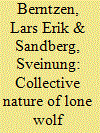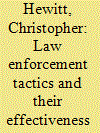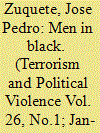|
|
|
Sort Order |
|
|
|
Items / Page
|
|
|
|
|
|
|
| Srl | Item |
| 1 |
ID:
134985


|
|
|
|
|
| Summary/Abstract |
Anders Behring Breivik, a lone wolf terrorist, killed 77 people in two terrorist attacks in Norway in 2011. This study uses framing theory from social movement studies to compare his Manifesto with the rhetoric of the anti-Islamic movement that inspired him. The anti-Islamic movement has a dual, and sometimes inconsistent, collective action framing. On the one hand, they portray Islam as an existential threat to the West and a warlike enemy; on the other, they promote peaceful and democratic opposition. The potential for radicalization is thus immanent. This case study reveals the importance of seeing lone wolf terrorists as acting from rhetoric embedded in larger social movements. It further demonstrates, in detail, the subtle and complex ways in which political narratives rejecting terrorism and political violence still end up inspiring such acts.
|
|
|
|
|
|
|
|
|
|
|
|
|
|
|
|
| 2 |
ID:
132362


|
|
|
|
|
| Publication |
2014.
|
| Summary/Abstract |
The article examines law-enforcement activities in 20 cases of terrorism and 38 cases of terrorism prevention, using published records. It proposes a seven-fold classification of police actions and examines which tactics were successful in identifying and apprehending perpetrators. Overall, in capturing those responsible for terrorist attacks, the most successful tactics were routine policing, the use of informers, and information provided by the public. Organized terrorism campaigns were most vulnerable to informers and surveillance, while the most effective tactics against lone wolves were witness identification and information from the public. The most successful terrorist preventions involved informers and surveillance.
|
|
|
|
|
|
|
|
|
|
|
|
|
|
|
|
| 3 |
ID:
132365


|
|
|
|
|
| Publication |
2014.
|
| Summary/Abstract |
Since the turn of the millennium in particular, protest movements have often been characterized by Black Bloc tactics of confrontation and street fighting between anarchist militants and police forces. This article analyses the Black Bloc's philosophy, dynamics, organization, praxis, and goals. After discussing the relationship between the Black Bloc and violence, the article analyses dynamics within militant anarchism that open the way for the formation of autonomous terrorist cells, as well as the potential for lone wolf terrorism in the movement.
|
|
|
|
|
|
|
|
|
|
|
|
|
|
|
|
| 4 |
ID:
172177


|
|
|
|
|
| Summary/Abstract |
This paper presents a case study of the Earth Liberation Front (ELF), based on interviews of the group’s former affiliates. It examines the role of credit claims in organizing this underground leaderless resistance group’s activity. In addition to the external signaling functions of credit claims—demonstrating capability, issuing demands, and soliciting public support—credit claims serve a movement-building role in the ELF. By issuing credit claims in “aboveground” fora that other cells are known to read, ELF cells with no direct links are able to communicate information to one another. Credit-claiming communiqués serve four organizing functions for the ELF. They constitute the ELF underground as an imagined community, recruit new cells, set agendas for future actions, and enforce operational standards of behavior via an informal “peer review” process. This study of the ELF suggests broader insights, including possible organizing techniques that may be observed in white supremacist and Islamist cases.
|
|
|
|
|
|
|
|
|
|
|
|
|
|
|
|
|
|
|
|
|